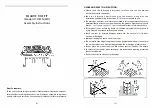
87D0174
27
SSTB11 Woodburning Fireplace
MAINTENANCE & SAFETY
Fuel Storage
Wood can be dried sufficiently for burning within a few
weeks if protected form rain in a low humidity area. It is
far better to cut wood and allow it to dry for a year. In all
cases, the wood should be stacked so that both ends of
the sticks are exposed to the air and protected from rain.
The drier the wood, the more usable heat produced by the
fire and less likely rapid accumulation of soot and creo-
sote within the chimney is to occur. See the section of this
manual concerning chimney maintenance for information
concerning the hazards of soot a creosote accumulation.
Small quantities of wood required for fire tending must be
kept at least 30 inches from the fireplace.
Disposal of Ashes
Ashes should be placed in a metal container with a tight
fitting lid. The closed container of ashes should be placed
on a noncombustible floor or on the ground well away
from all combustible materials pending final disposal. If
the ashes are disposed of by burial in soil or otherwise
locally dispersed, they should be retained in the closed
container until all cinder has thoroughly cooled. Ashes
should never be placed in a container with combustible
materials.
Chimney Maintenance
Creosote, Formation and Need for Removal: When wood
is burned slowly, it produces tar and other organic vapors,
which combine with expelled moisture to form creosote.
The creosote vapors condense in the relatively cool chim-
ney flue of a slow-burning fire. As a result, creosote resi-
due accumulates on the flue lining. When ignited, this
creosote makes an extremely hot fire.
The chimney should be inspected at least twice a year
during the heating season to determine if a creosote
buildup has occurred.
If creosote has accumulated it should be removed to re-
duce the risk of a chimney fire.
The chimney cap can be removed for inspection, main-
tenance and cleaning by removing three screws from the
support legs and lifting upward.
When the fireplace is first in use, inspect the chimney fre-
quently and clean the chimney any time an accumulation
is observed on the flue walls. The frequency of these in-
spections can be increased or reduced appropriately after
a pattern of accumulation has been established. Please
note, however, that changes in the outside environmental
conditions such as temperature and humidity or changes
in the operation of the fireplace can lead to rapid buildup
of soot and/or creosote.
To clean the chimney, obtain the services of a qualified
and reputable chimney sweep, or remove the accumula-
tion with brushes on wooden or fiberglass poles. Do not
use metal pipes, chains, wires, etc., to clean the chimney
because such items can scratch the surface of the stain-
less steel flue which can shorten the life of the flue and
provide a rough surface for soot particles to attach to.
Be sure to cover nearby furnishing and arrange some
method of catching soot and creosote particles that may
fall during the chimney cleaning process. If glass doors
are installed on the fireplace, they should be closed. Extra
caution must be used to avoid damage to the flue damper
during the cleaning process.
In addition to checking and cleaning the chimney on a
regular basis, be sure to inspect the chimney before start-
ing a fire at the beginning of each heating season. Make
sure the chimney is clear from any accumulation of soot,
creosote or any other debris, and that all joints are intact.
MHSC does not recommend chemical cleaners because
some may contain elements that corrode the metal parts
of the chimney or fireplace.
Fireplace Maintenance
At the end of each heating season or when the fireplace
will not be in use for an extended time, the ashes should
be removed and the hearth area should be swept as clean
as is practical. The slow absorption of moisture into the
ashes over a long period of time could cause a condition
which would be corrosive to the metal fireplace parts.
At the beginning of each heating season, always operate
the flue damper and make sure it has not become stuck
from soot, creosote, etc., during the period of inactivity.
Keep the lower and upper grille panels clean and free
from dirt and lint accumulation at all times to get the maxi-
mum efficiency from your fireplace.
As you use the fireplace, expansion and contraction will
cause minor cracking of the hearth, back, and side refrac-
tory materials. This is normal and unavoidable. If the
cracks become large enough or parts dislodge and metal
behind the refractory is exposed, the refractory panels
should be replaced with new panels that can be obtained
from you fireplace dealer.
Glass Door Maintenance
For glass door maintenance, see instructions provided
with the glass doors.
Checklist of Do’s and Dont’s
DO’S
1. Do check with local building officials to be sure the
installation of the fireplace complies with all building
codes and requirements and obtain required building
permits. Do plan your installation with safety as you
primary consideration.
2. Do use only the prescribed material and parts for the
installation of the fireplace.
3. Do insulate the exterior walls surrounding the fireplace
to prevent excessive heat loss from the fireplace.






































